Fire! Fire! Fire!
Neary 60 years ago an arson attack hugely changed the course of Scottish Speedway
Did the nocturnal activities of an arsonist on some dark winter nights in the late 1960s, consign the Glasgow Tigers to a nomadic existence which would see them move their home an amazing seven times in around thirty years? Doug Nicolson certainly thinks so.
Fire! Fire! Fire
The 1968 season had been a traumatic one for the Glasgow promotion and supporters and, while everyone was glad to see the back of it, no one doubted that they would all be back at the White City following spring. There was a question over the Tigers’ long term future at the stadium, but that seemed to be a problem for another year. The proposal, that the M8 motorway western extension would be routed through the north eastern corner of the White City site had been known for some time. Les Whaley, in reply to a supporters letter on the subject, said that the Tigers would have to move from the Paisley Road West venue, but not for “some years yet”.
During the winter of 1967/68, Ian Hoskins had scoured football grounds all over Central Scotland in his search for a new home for his Edinburgh Monarchs following the closure of Old Meadowbank. Albion Rovers’ Cliftonhill ground in Coatbridge was finally secured, but this was very much the last card in the pack. Any new venue for the Tigers would have to lie within the Glasgow city boundary, but where?
Prior to bringing speedway back to Glasgow in 1964, Trevor Redmond had approached Celtic FC, whose Parkhead stadium had previously staged speedway in 1928 but their board were not interested, while Rangers FC, whose Ibrox stadium was barely stone’s throw from the White City, were unlikely to have been any more amenable. Queens Park FC was the only amateur team to play in senior Scottish football and they seemed to stick firmly to their Corinthian ideals. It was felt they would rebuff any approach to use Hampden. Ashfield was not a possibility, as a greyhound track had been laid on top of the speedway circuit. Little was known about Carntyne and no mention was ever made about it being a prospective venue.
All of this left Cathkin Park as the best option. It was disused, being the former home of Third Lanark FC who went into liquidation at the end of the 1965/66 season. The stand ran the length of the home straight and provided cover for about 2500. There was a narrow track around the football pitch, but with football no longer being played, the pitch could be lifted to provide a track of ample width. In short, a track similar in size and shape to Old Meadowbank could be housed at Cathkin. The Speedway Star of 22nd November 1968 reported that the Tigers promotion was weighing up an approach to the owners. It ceainly looked that Cathkin would be the promotion’s first choice as the new home for the Tigers once they were required to leave their beloved White City.

However, things changed dramatically. On the night of the 21st October 1968, Hampden was badly damaged by a blaze, which destroyed much of the centre stand, the visitors’ dressing rooms and the main administration offices. The League Cup Final was due to be staged a few days later and its postponement added to Queens Park’s cash flow worries. Any thoughts that the fire had been accidental were dispelled when there was a similar fire at Ibrox Stadium the following night and the Cathkin stand was gutted a few weeks later. Cathkin was now no longer a viable option, while Queens Park was a club with financial problems and no real prospect of finding additional revenue streams.
In mid January 1969, Tom Fagan, the Albion Rovers chairman and the Monarchs landlord, had invited Ian Hoskins to make the short trip from his Shawlands home to be his guest at the Queens Park versus Albion Rovers game at Hampden. He introduced Hoskins to the Queens Park officials saying this was the man whose speedway had saved his football team. This certainly got plenty of attention and Hoskins both literally and metaphorically decided to strike while the iron was hot! The Queens Park management was not hard to deal with, and, within four weeks, the Speedway Star carried the news that Hampden was to be Tigers new home.

Hoskins may have been a bit too eager to conclude a deal and he would later rue his agreement to the speedway fence being removable. It was made in sections of about 12 feet, each being mounted on two poles, which slotted into retaining holes made in the track perimeter. Each fence section was numbered so that it would always be placed in the correct place. When major football events were staged on a Saturday afternoon, all of the fence was required to be removed and stored immediately after the Friday night speedway fixture. This was a mammoth task, which was only achieved by the dedication of numerous track staff who worked well into the night. Perhaps if a firmer negotiating stance had been taken, the football authorities may have been prepared to allow the first six rows of terracing to be surrendered to allow the track corners to be extended outwards giving a far wider circuit that would have offered far more racing lines. The track, formerly a 440 yards running track, had some turfs lifted from behind the goals and now measured 420 yards. It has to be said that it always was a bit too narrow. The late John Berry in his book “More Confessions” describes it as “too long and skinny to be a good racetrack, but I have certainly seen a lot worse around football pitches”, which is probably a fair summing up.
Further arson attacks continued in the area during the first half of 1969 with the Hampden Bowl, an adjacent ten pin bowling alley, as well as Hampden and Ibrox being torched. These were relatively minor but it was June before a “local man” was arrested. The fire raiser had destroyed any chance of Cathkin becoming Tigers home. Who knows, in time, it may have replaced the still lamented White City as Glasgow speedway’s spiritual home. Instead Tigers followed an almost nomadic existence, which has seen them decamp from Hampden to Coatbridge, and subsequently to Blantyre, Shawfield via Workington and Ashfield, where they remain to this day.
Would the sport have thrived, survived or died at Cathkin? All three possibly! But we never got the chance to find out.

Create Your Own Website With Webador